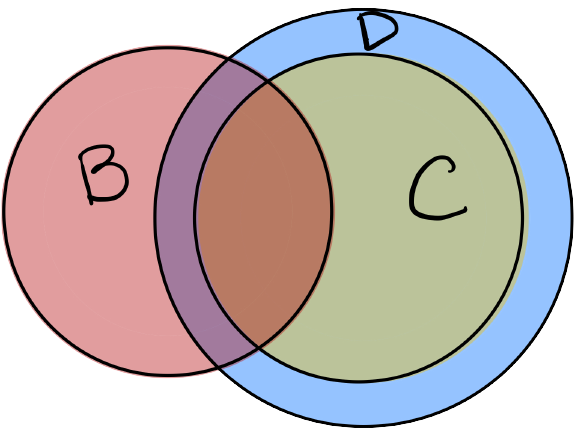In a children’s story there are three types of monster, Bongles, Crannies and Dervies. Some, but not all, Bongles are Crannies and all Crannies are Dervies.
Which one of the following is definitely NOT true?
A. Some Dervies are both Bongles and Crannies.
B. Some Dervies are neither Bongles nor Crannies.
C. All Crannies are either Bongles or Dervies or both.
D. No Dervies are Bongles.
E. Some Bongles are Dervies
Simple steps to solve word problems:
- Underline key information
- Determine what they are trying to ask, and what you will need to solve it
Eliminate any non-essential information
- Draw a picture, graph, or equation
Blockquote
In moments of high stress like exam taking, always work with the paper they give you to avoid careless mistakes.
The best approach is to have some kind of visual so we can picture each statement, and then we will go through each answer trying to prove it wrong. The simplest kind of drawing here is a Venn diagram style picture.
Let B stand for Bongles.
Let C stand for Crannies.
Let D stand for Dervies.

Since we know that but not all Bongles are Crannies, we draw the Bongles circle overlapping the Crannies but leaving an open area on each side because some Bongles are not Crannies (we are not told if all Crannies are Bongles, but this would still be theoretically possible). Next we draw a larger circle around the Crannies because we know that all Crannies are Dervices.
Unknowns: We are not told if all Crannies are Bongles, We do not know if some Dervies are Bongles but not Crannies, if they are only Dervies not jointly Crannies or Bongles.
A. This is true because we know that some Crannies are Bongles and all Crannies are Dervies, therefore some Dervies must both Crannies and Bongles. Therefore A is not the answer.
B. This was not specified in the text but it is possible. See in the image how there is an area of Dervies untouched from the Bongles or Crannies circles. Therefore B is not the answer.
C. This is true because all Crannies are Dervies. So Crannies can either be both Bongles and Dervies or only Dervies.
D. This cannot be concluded from the info given from us in the text. It is false because we know that some Crannies are Bongles and all Crannies are Dervies. With this info we know that all the Crannies that are Bongles are also Dervices. Therefore D is correct.
E. This can be true because Dervies are not only limited to being Crannies. There is a chance that Dervies and Bongles can overlap, and regardless, any Bongle that is a Crannie is also a Dervie. Therefore E is incorrect.
